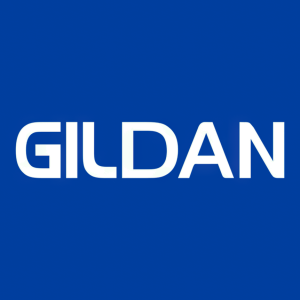Gildan Activewear Reports First Quarter 2021 Results and Reinstates Quarterly Dividend
Rhea-AI Summary
Gildan Activewear reported strong Q1 2021 results with sales of $590 million, a 28% increase from last year. GAAP diluted EPS was $0.50, boosted by a $0.09 one-time benefit from the USDA's Pandemic Assistance for Cotton Users (PACU). Gross margin improved to 32.0%, supported by effective cost management and the Back to Basics strategy. The company reinstated its quarterly dividend at $0.154 per share, payable on June 21, 2021, reflecting confidence in financial recovery. Free cash flow was $38 million for the quarter, and available liquidity stood at $1.6 billion.
Positive
- Sales increased by 28% year-over-year to $590 million.
- GAAP diluted EPS of $0.50, significantly up from a loss of $0.50 in Q1 2020.
- Reinstated quarterly dividend of $0.154 per share, indicating confidence in recovery.
- Free cash flow of $38 million in Q1 2021 compared to cash consumption of $235 million in Q1 2020.
- Improved gross margin to 32.0%, a year-over-year increase of 8.8 percentage points.
Negative
- Sales down approximately 5% from Q1 2019 levels.
- Net financial expenses increased by $2.9 million year-over-year, impacting overall profitability.
- Ongoing supply chain challenges, including labor shortages and port backlogs, could affect future performance.
News Market Reaction 1 Alert
On the day this news was published, GIL gained 1.00%, reflecting a mild positive market reaction.
Data tracked by StockTitan Argus on the day of publication.
(all amounts are in U.S. dollars except where otherwise indicated)
(1) Please refer to "Definition and reconciliation of non-GAAP financial measures" in this press release
- "Back to Basics" drives strong performance in quarter
- Sales of
$590 million , up28% over prior year - GAAP diluted EPS of
$0.50 and adjusted diluted EPS1 of$0.48 , including$0.09 one-time benefit from USDA’s Pandemic Assistance for Cotton Users (PACU) program - Operating margin of
19.3% , adjusted operating margin1 of18.7% , including 300 bps impact of PACU benefit - Reinstatement of quarterly dividend of
$0.15 4 per share, in-line with dividend level prior to suspension
MONTREAL, May 05, 2021 (GLOBE NEWSWIRE) -- Gildan Activewear Inc. (GIL: TSX and NYSE) today announced its results for the first quarter ended April 4, 2021.
“Our first quarter results reflected a strong start to 2021 as continued benefits from our Back to Basics strategy supported sell-through across all channels and drove strong operating margin performance, allowing us to deliver net earnings significantly above prior year and first quarter 2019 levels” said Gildan President and CEO, Glenn J. Chamandy. “While large events have not yet restarted, we continue to be encouraged by the strength of our imprintables business and on the retail side we were pleased with strong double-digit growth in underwear and activewear sales compared to the first quarters of 2020 and 2019.”
Overall, the Company generated
During the first quarter, we generated strong free cash flow1 of
Q1 2021 Operating Results
Net sales for the first quarter ending April 4, 2021, of
Our reported gross margin in the first quarter was
SG&A expenses for the first quarter of
We generated operating income of
We generated strong free cash flow of
Current Market Environment
Our POS in imprintables channels as we moved from the first quarter into the second quarter has been running slightly better, with overall POS in U.S. and international markets down approximately
Declaration of Quarterly Dividend
The Board of Directors has declared a cash dividend of
Disclosure of Outstanding Share Data
As at April 30, 2021, there were 198,429,822 common shares issued and outstanding along with 3,519,127 stock options and 17,818 dilutive restricted share units (Treasury RSUs) outstanding. Each stock option entitles the holder to purchase one common share at the end of the vesting period at a pre-determined option price. Each Treasury RSU entitles the holder to receive one common share from treasury at the end of the vesting period, without any monetary consideration being paid to the Company.
Conference Call Information
Gildan Activewear Inc. will hold a conference call to discuss the Company's first quarter 2021 results today at 5:00 PM ET. A live audio webcast of the conference call, as well as a replay, will be available on its corporate site or on the following link: https://gildancorp.com/en/investors/events-and-presentations/. The conference call can be accessed by dialing (877) 282-2924 (Canada & U.S.) or (470) 495-9480 (international) and entering passcode 4652399#. A replay will be available for 7 days starting at 8:00 PM ET by dialing (855) 859-2056 (Canada & U.S.) or (404) 537-3406 (international) and entering the same passcode.
Notes
This release should be read in conjunction with Gildan’s Management’s Discussion and Analysis and its unaudited condensed interim consolidated financial statements as at and for the three months ended April 4, 2021, which will be filed by Gildan with the Canadian securities regulatory authorities and with the U.S. Securities and Exchange Commission and which will be available on Gildan’s corporate website.
Certain minor rounding variances may exist between the unaudited condensed interim consolidated financial statements and the table summaries contained in this press release.
Supplemental Financial Data
CONSOLIDATED FINANCIAL DATA (UNAUDITED)
| (in $ millions, except per share amounts or otherwise indicated) | Q1 2021 | Q1 2020 | Variation (%) | ||||||
| Net sales | 589.6 | 459.1 | 28.4 | % | |||||
| Gross profit | 188.5 | 106.5 | 77.0 | % | |||||
| Adjusted gross profit(1) | 183.5 | 114.5 | 60.3 | % | |||||
| SG&A expenses | 73.4 | 73.9 | (0.7 | ) | % | ||||
| (Reversal of impairment) Impairment of trade accounts receivable | (0.2 | ) | 20.8 | n.m. | |||||
| Restructuring and acquisition-related costs | 1.5 | 10.2 | (85.3 | ) | % | ||||
| Impairment of goodwill and intangible assets | — | 94.0 | n.m. | ||||||
| Operating income (loss) | 113.8 | (92.3 | ) | n.m. | |||||
| Adjusted operating income(1) | 110.3 | 19.9 | n.m. | ||||||
| Adjusted EBITDA(1) | 145.8 | 50.2 | n.m. | ||||||
| Financial expenses | 10.8 | 7.9 | 36.7 | % | |||||
| Income tax expense (recovery) | 4.4 | (0.9 | ) | n.m. | |||||
| Net earnings (loss) | 98.5 | (99.3 | ) | n.m. | |||||
| Adjusted net earnings(1) | 95.0 | 11.2 | n.m. | ||||||
| Basic EPS | 0.50 | (0.50 | ) | n.m. | |||||
| Diluted EPS | 0.50 | (0.50 | ) | n.m. | |||||
| Adjusted diluted EPS(1) | 0.48 | 0.06 | n.m. | ||||||
| Gross margin | 32.0 | % | 23.2 | % | 8.8 | pp | |||
| Adjusted gross margin(1) | 31.1 | % | 24.6 | % | 6.5 | pp | |||
| SG&A expenses as a percentage of sales | 12.4 | % | 16.1 | % | (3.7 | ) | pp | ||
| Operating margin | 19.3 | % | (20.1 | ) | % | 39.4 | pp | ||
| Adjusted operating margin(1) | 18.7 | % | 4.3 | % | 14.4 | pp | |||
| Cash flows from (used in) operating activities | 20.6 | (209.4 | ) | n.m. | |||||
| Capital expenditures | (13.1 | ) | (25.6 | ) | (48.8 | ) | % | ||
| Free cash flow(1) | 37.6 | (235.0 | ) | n.m. | |||||
n.m. = not meaningful
| As at | Apr 4, 2021 | Jan 3, 2021 | ||
| Inventories | 736.4 | 728.0 | ||
| Trade accounts receivable | 268.6 | 196.5 | ||
| Net indebtedness(1) | 541.6 | 577.2 | ||
| Net debt leverage ratio(1)(2) | 2.1 | 3.5 |
(1) Please refer to "Definition and reconciliation of non-GAAP financial measures" in this press release.
(2) The Company's net debt to EBITDA ratio for purposes of its loan and note agreements was 1.1 at April 4, 2021.
DISAGGREGATION OF REVENUE
Net sales by major product group were as follows:
| (in $ millions, or otherwise indicated) | Q1 2021 | Q1 2020 | Variation (%) | |||
| Activewear | 484.6 | 372.6 | 30.1 | % | ||
| Hosiery and underwear | 105.0 | 86.5 | 21.4 | % | ||
| 589.6 | 459.1 | 28.4 | % |
Net sales were derived from customers located in the following geographic areas:
| (in $ millions, or otherwise indicated) | Q1 2021 | Q1 2020 | Variation (%) | |||
| United States | 508.7 | 389.3 | 30.7 | % | ||
| Canada | 22.6 | 16.3 | 38.7 | % | ||
| International | 58.3 | 53.4 | 9.2 | % | ||
| 589.6 | 459.0 | 28.4 | % |
Definition and Reconciliation of Non-GAAP Financial Measures
This press release includes references to certain non-GAAP financial measures as described below. These non-GAAP measures do not have any standardized meanings prescribed by International Financial Reporting Standards (IFRS) and are therefore unlikely to be comparable to similar measures presented by other companies. Accordingly, they should not be considered in isolation. The terms and definitions of the non-GAAP measures used in this press release and a reconciliation of each non-GAAP measure to the most directly comparable IFRS measure are provided below. The non-GAAP measures are presented on a consistent basis for all periods presented in this press release, except as otherwise discussed below.
Adjusted net earnings and adjusted diluted EPS
Adjusted net earnings are calculated as net earnings before restructuring and acquisition-related costs, income taxes relating to restructuring and acquisition-related actions, income taxes related to the re-assessment of the probability of realization of previously recognized or de-recognized deferred income tax assets, and income taxes relating to the revaluation of deferred income tax assets and liabilities as a result of statutory income tax rate changes in the countries in which we operate. Adjusted net earnings also excludes impairment of goodwill and intangible assets, net insurance gains related to the two hurricanes which impacted the Company’s operations in Central America, the discontinuance of personal protective equipment (PPE) stock-keeping unit (SKUs), the impact of the Company's strategic initiative to significantly reduce its retail product line SKU count which the Company began implementing in the fourth quarter of fiscal 2020, and the impact of adjustments related to the Company’s decision in the fourth quarter of fiscal 2019 to implement a strategic initiative to significantly reduce its imprintables product line SKU count, by exiting all ship to-the-piece activities and discontinuing overlapping and less productive styles and SKUs between brands. These product line initiatives are aimed at simplifying the Company's product portfolio and reducing complexity in its manufacturing and warehouse distribution activities. The impact of the strategic initiatives includes inventory write-downs and a sales return allowance for anticipated product returns related to discontinued SKUs. Adjusted diluted EPS is calculated as adjusted net earnings divided by the diluted weighted average number of common shares outstanding. The Company uses adjusted net earnings and adjusted diluted EPS to measure its performance from one period to the next, without the variation caused by the impacts of the items described above. The Company excludes these items because they affect the comparability of its financial results and could potentially distort the analysis of trends in its business performance. Excluding these items does not imply they are necessarily non-recurring.
| (in $ millions, except per share amounts) | Q1 2021 | Q1 2020 | ||||
| Net earnings (loss) | 98.5 | (99.3 | ) | |||
| Adjustments for: | ||||||
| Restructuring and acquisition-related costs | 1.5 | 10.2 | ||||
| Impairment of goodwill and intangible assets | — | 94.0 | ||||
| Impact of strategic product line initiatives(1) | 1.2 | 8.0 | ||||
| Net insurance gains(2) | (6.2 | ) | — | |||
| Income tax recovery relating to the above-noted adjustments | — | (1.7 | ) | |||
| Adjusted net earnings | 95.0 | 11.2 | ||||
| Basic EPS | 0.50 | (0.50 | ) | |||
| Diluted EPS | 0.50 | (0.50 | ) | |||
| Adjusted diluted EPS | 0.48 | 0.06 | ||||
(1) Includes
(2) Net insurance gains are related to the two hurricanes that occurred in Central America in November 2020, consisting of the following costs which were more than offset by related accrued insurance recoveries to date: losses on disposal of unrepairable equipment, equipment repairs, salary and benefits continuation for idle employees, and other costs, and unabsorbed salary, benefits, and overhead costs, that resulted from related production interruptions.
Adjusted gross profit and adjusted gross margin
Adjusted gross profit is calculated as gross profit excluding the impact of net insurance gains related to the two hurricanes which impacted the Company’s operations in Central America, the discontinuance of PPE SKUs, the impact of the Company's strategic initiative to significantly reduce its retail product line SKU count which the Company began implementing in the fourth quarter of fiscal 2020, and the impact of adjustments related to the Company’s decision in the fourth quarter of fiscal 2019 to implement a strategic initiative to significantly reduce its imprintables product line SKU count, by exiting all ship to-the-piece activities and discontinuing overlapping and less productive styles and SKUs between brands. These product line initiatives are aimed at simplifying the Company's product portfolio and reducing complexity in its manufacturing and warehouse distribution activities. The impact of the strategic initiatives includes inventory write-downs and a sales return allowance for anticipated product returns related to discontinued SKUs. Adjusted gross margin is calculated as adjusted gross profit divided by net sales excluding the sales return allowance for anticipated product returns related to discontinued SKUs. The Company uses adjusted gross profit and adjusted gross margin to measure its performance from one period to the next, without the variation caused by the impacts of the items described above. The Company excludes these items because they affect the comparability of its financial results and could potentially distort the analysis of trends in its business performance. Excluding these items does not imply they are necessarily non-recurring.
| (in $ millions, or otherwise indicated) | Q1 2021 | Q1 2020 | ||
| Gross profit | 188.5 | 106.5 | ||
| Adjustments for: | ||||
| Impact of strategic product line initiatives(1) | 1.2 | 8.0 | ||
| Net insurance gains(1) | (6.2 | ) | — | |
| Adjusted gross profit | 183.5 | 114.5 | ||
| Gross margin | 32.0 | % | 23.2 | % |
| Adjusted gross margin(2) | 31.1 | % | 24.6 | % |
(1) See footnotes to table "Adjusted net earnings and adjusted diluted EPS" in this press release.
(2) Calculated as adjusted gross profit divided by net sales excluding the sales return allowance for anticipated product returns related to discontinued SKUs.
Adjusted operating income and adjusted operating margin
Adjusted operating income is calculated as operating income before restructuring and acquisition-related costs. Adjusted operating income also excludes impairment of goodwill and intangible assets, net insurance gains related to the two hurricanes which impacted the Company’s operations in Central America, the discontinuance of PPE SKUs, the impact of the Company's strategic initiative to significantly reduce its retail product line SKU count which the Company began implementing in the fourth quarter of fiscal 2020, and the impact of adjustments related to the Company’s decision in the fourth quarter of fiscal 2019 to implement a strategic initiative to significantly reduce its imprintables product line SKU count, by exiting all ship to-the-piece activities and discontinuing overlapping and less productive styles and SKUs between brands. These product line initiatives are aimed at simplifying the Company's product portfolio and reducing complexity in its manufacturing and warehouse distribution activities. The impact of the strategic initiatives includes inventory write-downs and a sales return allowance for anticipated product returns related to discontinued SKUs. Adjusted operating margin is calculated as adjusted operating income divided by net sales excluding the sales return allowance for anticipated product returns related to discontinued SKUs. Management uses adjusted operating income and adjusted operating margin to measure its performance from one period to the next, without the variation caused by the impacts of the items described above. The Company excludes these items because they affect the comparability of its financial results and could potentially distort the analysis of trends in its business performance. Excluding these items does not imply they are necessarily non-recurring.
| (in $ millions, or otherwise indicated) | Q1 2021 | Q1 2020 | ||||
| Operating income (loss) | 113.8 | (92.3 | ) | |||
| Adjustment for: | ||||||
| Restructuring and acquisition-related costs | 1.5 | 10.2 | ||||
| Impairment of goodwill and intangible assets | — | 94.0 | ||||
| Impact of strategic product line initiatives(1) | 1.2 | 8.0 | ||||
| Net insurance gains(1) | (6.2 | ) | — | |||
| Adjusted operating income | 110.3 | 19.9 | ||||
| Operating margin | 19.3 | % | (20.1 | ) | % | |
| Adjusted operating margin(2) | 18.7 | % | 4.3 | % |
(1) See footnotes to table "Adjusted net earnings and adjusted diluted EPS" in this press release.
(2) Calculated as adjusted operating income divided by net sales excluding the sales return allowance for anticipated product returns related to discontinued SKUs.
Adjusted EBITDA
Adjusted EBITDA is calculated as earnings before financial expenses, income taxes, and depreciation and amortization, and excludes the impact of restructuring and acquisition-related costs. Adjusted EBITDA also excludes impairment of goodwill and intangible assets, net insurance gains related to the two hurricanes which impacted the Company’s operations in Central America, the discontinuance of PPE SKUs, the impact of the Company's strategic initiative to significantly reduce its retail product line SKU count which the Company began implementing in the fourth quarter of fiscal 2020, and the impact of adjustments related to the Company’s decision in the fourth quarter of fiscal 2019 to implement a strategic initiative to significantly reduce its imprintables product line SKU count, by exiting all ship to-the-piece activities and discontinuing overlapping and less productive styles and SKUs between brands. These product line initiatives are aimed at simplifying the Company's product portfolio and reducing complexity in its manufacturing and warehouse distribution activities. The impact of the strategic initiatives includes inventory write-downs and a sales return allowance for anticipated product returns related to discontinued SKUs. The Company uses adjusted EBITDA, among other measures, to assess the operating performance of its business. The Company also believes this measure is commonly used by investors and analysts to measure a company’s ability to service debt and to meet other payment obligations, or as a common valuation measurement. The Company excludes depreciation and amortization expenses, which are non-cash in nature and can vary significantly depending upon accounting methods or non-operating factors. Excluding these items does not imply they are necessarily non-recurring.
| (in $ millions) | Q1 2021 | Q1 2020 | ||||
| Net earnings (loss) | 98.5 | (99.3 | ) | |||
| Restructuring and acquisition-related costs | 1.5 | 10.2 | ||||
| Impairment of goodwill and intangible assets | — | 94.0 | ||||
| Impact of strategic product line initiatives(1) | 1.2 | 8.0 | ||||
| Net insurance gains(1) | (6.2 | ) | — | |||
| Depreciation and amortization | 35.6 | 30.3 | ||||
| Financial expenses, net | 10.8 | 7.9 | ||||
| Income tax expense (recovery) | 4.4 | (0.9 | ) | |||
| Adjusted EBITDA | 145.8 | 50.2 |
(1) See footnotes to table "Adjusted net earnings and adjusted diluted EPS" in this press release.
Free cash flow
Free cash flow is defined as cash from operating activities, less cash flow used in investing activities excluding business acquisitions. The Company considers free cash flow to be an important indicator of the financial strength and liquidity of its business, and it is a key metric which indicates how much cash is available after capital expenditures to repay debt, to pursue business acquisitions, and/or to redistribute to its shareholders. The Company believes this measure is commonly used by investors and analysts when valuing a business and its underlying assets.
| (in $ millions) | Q1 2021 | Q1 2020 | |||
| Cash flows from (used in) operating activities | 20.6 | (209.4 | ) | ||
| Cash flows from (used in) investing activities | 17.0 | (25.6 | ) | ||
| Adjustment for: | |||||
| Business acquisitions | — | — | |||
| Free cash flow | 37.6 | (235.0 | ) | ||
Total indebtedness and net indebtedness
Total indebtedness is defined as the total bank indebtedness, long-term debt (including any current portion), and lease obligations (including any current portion), and net indebtedness is calculated as total indebtedness net of cash and cash equivalents. The Company considers total indebtedness and net indebtedness to be important indicators of the financial leverage of the Company.
| (in $ millions) | Apr 4, 2021 | Jan 3, 2021 | ||||
| Long-term debt and total bank indebtedness | 1,000.0 | 1,000.0 | ||||
| Lease obligations | 77.6 | 82.5 | ||||
| Total indebtedness | 1,077.6 | 1,082.5 | ||||
| Cash and cash equivalents | (536.0 | ) | (505.3 | ) | ||
| Net indebtedness | 541.6 | 577.2 |
Net debt leverage ratio
The net debt leverage ratio is defined as the ratio of net indebtedness to pro-forma adjusted EBITDA for the trailing twelve months. The pro-forma adjusted EBITDA for the trailing twelve months reflects business acquisitions made during the period, as if they had occurred at the beginning of the trailing twelve month period. The Company has set a fiscal year-end net debt leverage target ratio of one to two times pro-forma adjusted EBITDA for the trailing twelve months. Due to the current economic environment, the Company is currently slightly above its target year-end range. The Company uses and believes that certain investors and analysts use the net debt leverage ratio to measure the financial leverage of the Company.
| (in $ millions, or otherwise indicated) | Apr 4, 2021 | Jan 3, 2021 | ||
| Adjusted EBITDA for the trailing twelve months | 260.8 | 165.1 | ||
| Adjustment for: | ||||
| Business acquisitions | — | — | ||
| Pro-forma adjusted EBITDA for the trailing twelve months | 260.8 | 165.1 | ||
| Net indebtedness | 541.6 | 577.2 | ||
| Net debt leverage ratio(1) | 2.1 | 3.5 | ||
(1) The Company's net debt to EBITDA ratio for purposes of its loan and note agreements was 1.1 at April 4, 2021.
Caution Concerning Forward-Looking Statements
Certain statements included in this press release constitute “forward-looking statements” within the meaning of the U.S. Private Securities Litigation Reform Act of 1995 and Canadian securities legislation and regulations and are subject to important risks, uncertainties, and assumptions. This forward-looking information includes, amongst others, information with respect to our objectives and the strategies to achieve these objectives, as well as information with respect to our beliefs, plans, expectations, anticipations, estimates, and intentions. Forward-looking statements generally can be identified by the use of conditional or forward-looking terminology such as “may”, “will”, “expect”, “intend”, “estimate”, “project”, “assume”, “anticipate”, “plan”, “foresee”, “believe”, or “continue”, or the negatives of these terms or variations of them or similar terminology. We refer you to the Company’s filings with the Canadian securities regulatory authorities and the U.S. Securities and Exchange Commission, as well as the risks described under the “Financial risk management”, “Critical accounting estimates and judgments”, and “Risks and uncertainties” sections of our most recent Management’s Discussion and Analysis for a discussion of the various factors that may affect the Company’s future results. Material factors and assumptions that were applied in drawing a conclusion or making a forecast or projection are also set out throughout such document and this press release.
Forward-looking information is inherently uncertain and the results or events predicted in such forward-looking information may differ materially from actual results or events. Material factors, which could cause actual results or events to differ materially from a conclusion, forecast, or projection in such forward-looking information, include, but are not limited to:
- the magnitude and length of economic disruption as a result of the worldwide coronavirus (COVID-19) pandemic and the more recent appearance of COVID variants, including the scope and duration of government mandated general, partial, or targeted private sector shutdowns, travel restrictions, social distancing measures, and the pace of mass vaccination campaigns;
- changes in general economic and financial conditions globally or in one or more of the markets we serve, including those resulting from the impact of the COVID-19 pandemic and the more recent appearance of COVID variants;
- our ability to implement our growth strategies and plans;
- our ability to successfully integrate acquisitions and realize expected benefits and synergies;
- the intensity of competitive activity and our ability to compete effectively;
- our reliance on a small number of significant customers;
- the fact that our customers do not commit to minimum quantity purchases;
- our ability to anticipate, identify, or react to changes in consumer preferences and trends;
- our ability to manage production and inventory levels effectively in relation to changes in customer demand;
- fluctuations and volatility in the price of raw materials used to manufacture our products, such as cotton, polyester fibres, dyes and other chemicals;
- our reliance on key suppliers and our ability to maintain an uninterrupted supply of raw materials and finished goods;
- the impact of climate, political, social, and economic risks, natural disasters, epidemics, pandemics and endemics, such as the COVID-19 pandemic, in the countries in which we operate or sell to, or from which we source production;
- disruption to manufacturing and distribution activities due to such factors as operational issues, disruptions in transportation logistic functions, labour shortages or disruptions, political or social instability, weather-related events, natural disasters, epidemics and pandemics, such as the COVID-19 pandemic, and other unforeseen adverse events;
- the impacts of the COVID-19 pandemic on our business and financial performance and consequently on our ability to comply with the financial covenants under our debt agreements;
- compliance with applicable trade, competition, taxation, environmental, health and safety, product liability, employment, patent and trademark, corporate and securities, licensing and permits, data privacy, bankruptcy, anti-corruption, and other laws and regulations in the jurisdictions in which we operate;
- the imposition of trade remedies, or changes to duties and tariffs, international trade legislation, bilateral and multilateral trade agreements and trade preference programs that the Company is currently relying on in conducting its manufacturing operations or the application of safeguards thereunder;
- factors or circumstances that could increase our effective income tax rate, including the outcome of any tax audits or changes to applicable tax laws or treaties;
- changes to and failure to comply with consumer product safety laws and regulations;
- changes in our relationship with our employees or changes to domestic and foreign employment laws and regulations;
- negative publicity as a result of actual, alleged, or perceived violations of human rights, labour and environmental laws or international labour standards, or unethical labour or other business practices by the Company or one of its third-party contractors;
- changes in third-party licensing arrangements and licensed brands;
- our ability to protect our intellectual property rights;
- operational problems with our information systems as a result of system failures, viruses, security and cyber security breaches, disasters, and disruptions due to system upgrades or the integration of systems;
- an actual or perceived breach of data security;
- our reliance on key management and our ability to attract and/or retain key personnel;
- changes in accounting policies and estimates; and
- exposure to risks arising from financial instruments, including credit risk on trade accounts receivables and other financial instruments, liquidity risk, foreign currency risk, and interest rate risk, as well as risks arising from commodity prices.
These factors may cause the Company’s actual performance and financial results in future periods to differ materially from any estimates or projections of future performance or results expressed or implied by such forward-looking statements. Forward-looking statements do not take into account the effect that transactions or non-recurring or other special items announced or occurring after the statements are made may have on the Company’s business. For example, they do not include the effect of business dispositions, acquisitions, other business transactions, asset write-downs, asset impairment losses, or other charges announced or occurring after forward-looking statements are made. The financial impact of such transactions and non-recurring and other special items can be complex and depends on the facts particular to each of them.
There can be no assurance that the expectations represented by our forward-looking statements will prove to be correct. The purpose of the forward-looking statements is to provide the reader with a description of management’s expectations regarding the Company’s future financial performance and may not be appropriate for other purposes. Furthermore, unless otherwise stated, the forward-looking statements contained in this press release are made as of the date of this press release, and we do not undertake any obligation to update publicly or to revise any of the included forward-looking statements, whether as a result of new information, future events, or otherwise unless required by applicable legislation or regulation. The forward-looking statements contained in this press release are expressly qualified by this cautionary statement.
About Gildan
Gildan is a leading manufacturer of everyday basic apparel which markets its products in North America, Europe, Asia-Pacific, and Latin America, under a diversified portfolio of Company-owned brands, including Gildan®, American Apparel®, Comfort Colors®, Gildan® Hammer™, Prim + Preux®, GoldToe®, Anvil® by Gildan®, Alstyle®, Secret®, Silks®, Kushyfoot®, Secret Silky®, Therapy Plus®, Peds® and MediPeds®, and under the Under Armour® brand through a sock licensing agreement providing exclusive distribution rights in the United States and Canada. Our product offering includes activewear, underwear, socks, hosiery, and legwear products sold to a broad range of customers, including wholesale distributors, screenprinters or embellishers, as well as to retailers that sell to consumers through their physical stores and/or e-commerce platforms, and to global lifestyle brand companies.
Gildan owns and operates vertically-integrated, large-scale manufacturing facilities which are primarily located in Central America, the Caribbean, North America, and Bangladesh. With approximately 46,000 employees worldwide, Gildan operates with a strong commitment to industry-leading labour and environmental practices throughout its supply chain in accordance with its comprehensive Genuine Responsibility® program embedded in the Company's long-term business strategy. More information about the Company and its corporate citizenship practices and initiatives can be found at www.gildancorp.com and www.genuineresponsibility.com, respectively.
| Investor inquiries: Sophie Argiriou Vice President, Investor Communications (514) 343-8815 sargiriou@gildan.com | Media inquiries: Genevieve Gosselin Director, Corporate Communications & Marketing (514) 343-8814 ggosselin@gildan.com |








